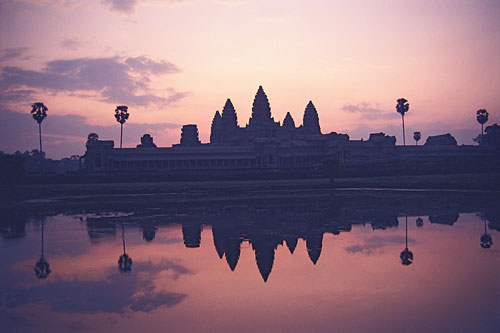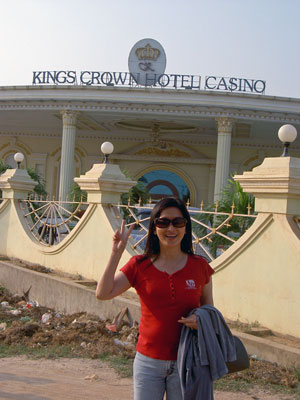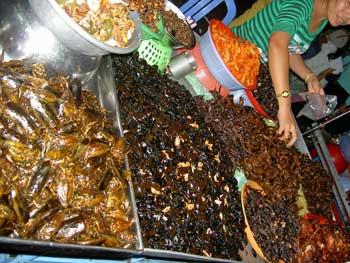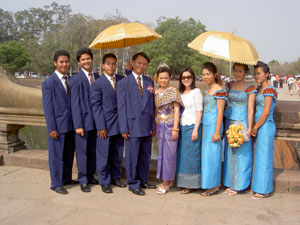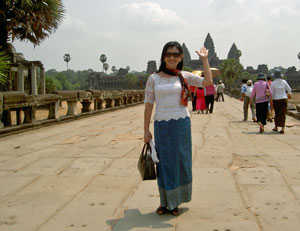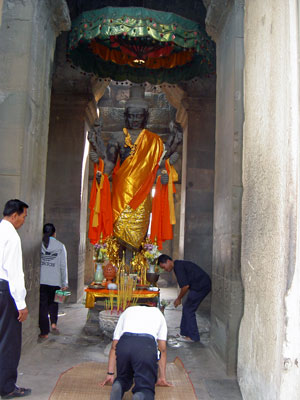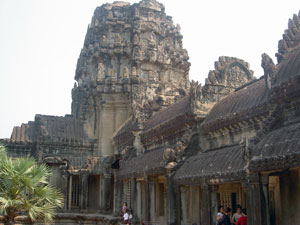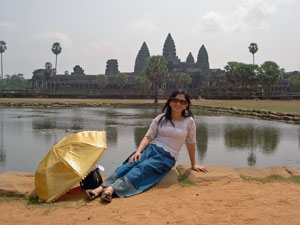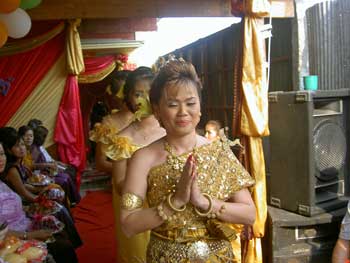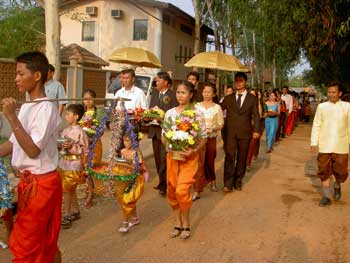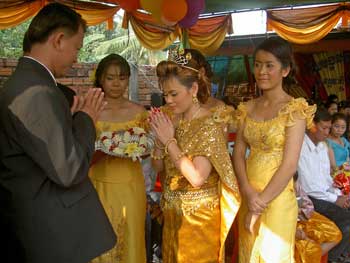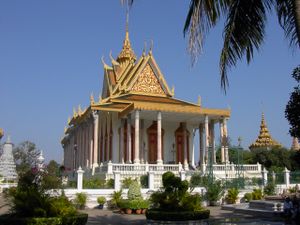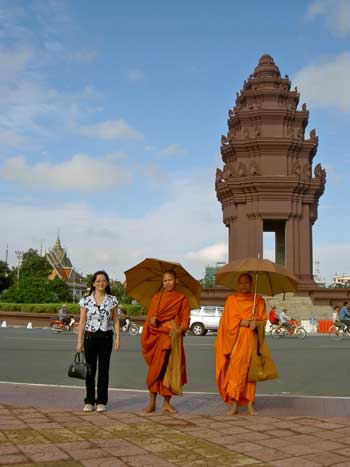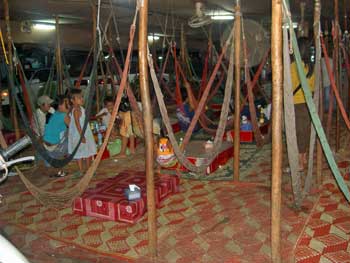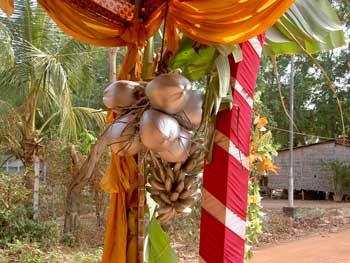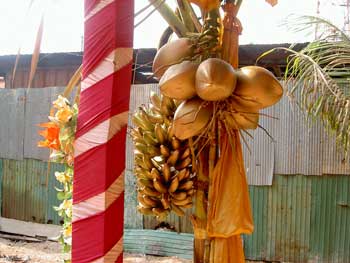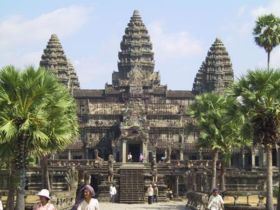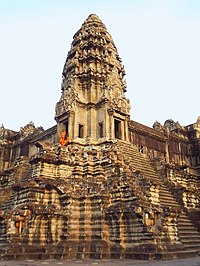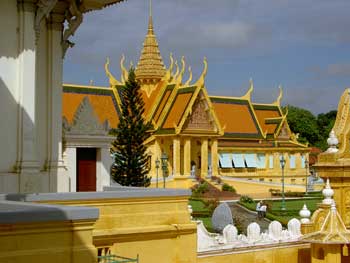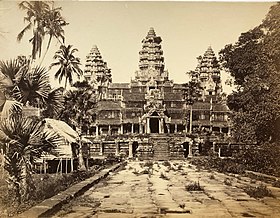
In the 14th or 15th century the temple was converted to Theravada Buddhist use, which continues to the present day. Angkor Wat is unusual among the Angkor temples in that although it was somewhat neglected after the 16th century it was never completely abandoned. Its moat also provided some protection from encroachment by the jungle.[2] Around this time the temple was known as Preah Pisnulok, after the posthumous title of Suryavarman.[3] The modern name, in use by the 16th century,[4] means "City Temple": Angkor is a vernacular form of the word nokor which comes from the Sanskrit word nagara (capital), while wat is the Khmer word for temple.
One of the first Western visitors to the temple was Antonio da Magdalena, a Portuguese monk who visited in 1586 and said that it "is of such extraordinary construction that it is not possible to describe it with a pen, particularly since it is like no other building in the world. It has towers and decoration and all the refinements which the human genius can conceive of".[5] However, the temple was popularised in the West only in the mid-19th century on the publication of Henri Mouhot's travel notes. The French explorer wrote of it:
One of these temples—a rival to that of Solomon, and erected by some ancient Michelangelo—might take an honourable place beside our most beautiful buildings. It is grander than anything left to us by Greece or Rome, and presents a sad contrast to the state of barbarism in which the nation is now plunged.[6]
Mouhot, like other early Western visitors, was unable to believe that the Khmers could have built the temple, and mistakenly dated it to around the same era as Rome. The true history of Angkor Wat was pieced together only from stylistic and epigraphic evidence accumulated during the subsequent clearing and restoration work carried out across the whole Angkor site.
Angkor Wat required considerable restoration in the 20th century, mainly the removal of accumulated earth and vegetation.[7] Work was interrupted by the civil war and Khmer Rouge control of the country during the 1970s and 1980s, but relatively little damage was done during this period other than the theft and destruction of mostly post-Angkorian statues.[8]
The temple has become a symbol of Cambodia, and is a source of great pride for the country's people. A depiction of Angkor Wat has been a part of every Cambodian national flag since the introduction of the first version circa 1863[9]—the only building to appear on any national flag.[10] In January 2003 riots erupted in Phnom Penh when a false rumour circulated that a Thai soap opera actress had claimed that Angkor Wat belonged to Thailand.[11]
Style

Angkor Wat is the prime example of the classical style of Khmer architecture—the Angkor Wat style—to which it has given its name. By the 12th century Khmer architects had become more skilled and confident than before in the use of sandstone (rather than brick or laterite) as the main building material. The Angkor Wat style was followed by that of the Bayon period, in which quality was often sacrificed to quantity.[12] Other temples in the style are Banteay Samré, Thommanon, Chao Say Tevoda and the early temples of Preah Pithu at Angkor; outside Angkor, Beng Mealea and parts of Phanom Rung and Phimai.
Angkor Wat has drawn praise above all for the harmony of its design, which has been compared to the architecture of ancient Greece or Rome. According to Maurice Glaize, a mid-20th-century conservator of Angkor, the temple "attains a classic perfection by the restrained monumentality of its finely balanced elements and the precise arrangement of its proportions. It is a work of power, unity and style."[13]
Architecturally, the elements characteristic of the style include: the ogival, redented towers shaped like lotus buds; half-galleries to broaden passageways; axial galleries connecting enclosures; and the cruciform terraces which appear along the main axis of the temple. Most of the visible areas are of sandstone blocks, while laterite was used for the outer wall and for hidden structural parts. The binding agent used to join the blocks is yet to be identified, although natural resins or slaked lime have been suggested.[14] Other elements of the design have been destroyed by looting and the passage of time, including gilded stucco on the towers, gilding on some figures on the bas-reliefs, and wooden ceiling panels and doors.[15] Typical decorative elements are devatas (or apsaras), bas-reliefs, and on pediments extensive garlands and narrative scenes. Statuary is conservative, being more static and less graceful than earlier work.[16]
The site
Angkor Wat, located at , is a unique combination of the temple mountain, the standard design for the empire's state temples, the later plan of concentric galleries, and the later Chola of Tamil Nadu India. The temple is a representation of Mount Meru, the home of the gods: the central quincunx of towers symbolises the five peaks of the mountain, and the walls and moat the surrounding mountain ranges and ocean.[17] Access to the upper areas of the temple was progressively more exclusive, with the laity being admitted only to the lowest level.[18]
Unlike most Khmer temples, Angkor Wat is oriented to the west rather than the east. This has led many (including Glaize and George Coedès) to conclude that Suryavarman intended it to serve as his funerary temple.[19] Further evidence for this view is provided by the bas-reliefs, which proceed in a counter-clockwise direction—prasavya in Hindu terminology—as this is the reverse of the normal order. Rituals take place in reverse order during Brahminic funeral services.[20] The archaeologist Charles Higham also describes a container which may have been a funerary jar which was recovered from the central tower.[21] Freeman and Jacques, however, note that several other temples of Angkor depart from the typical eastern orientation, and suggest that Angkor Wat's alignment was due to its dedication to Vishnu, who was associated with the west.[22]
A further interpretation of Angkor Wat has been proposed by Eleanor Mannikka. Drawing on the temple's alignment and dimensions, and on the content and arrangement of the bas-reliefs, she argues that these indicate a claimed new era of peace under king Suryavarman II: "as the measurements of solar and lunar time cycles were built into the sacred space of Angkor Wat, this divine mandate to rule was anchored to consecrated chambers and corridors meant to perpetuate the king's power and to honor and placate the deities manifest in the heavens above."[23] Mannikka's suggestions have been received with a mixture of interest and scepticism in academic circles.[24] She distances herself from the speculations of others, such as Graham Hancock, that Angkor Wat is part of a representation of the constellation Draco.[25]
Outer enclosure
The outer wall, 1025 by 802 m and 4.5 m high, is surrounded by a 30 m apron of open ground and a moat 190 m wide. Access to the temple is by an earth bank to the east and a sandstone causeway to the west; the latter, the main entrance, is a later addition, possibly replacing a wooden bridge.[26] There are gopuras at each of the cardinal points; the western is much the largest and has three ruined towers. Glaize notes that this gopura both hides and echoes the form of the temple proper.[27] Under the southern tower is a statue of Vishnu, known as Ta Reach, which may originally have occupied the temple's central shrine.[28] Galleries run between the towers and as far as two further entrances on either side of the gopura often referred to as "elephant gates", as they are large enough to admit those animals. These galleries have square pillars on the outer (west) side and a closed wall on the inner (east) side. The ceiling between the pillars is decorated with lotus rosettes; the west face of the wall with dancing figures; and the east face of the wall with balustered windows, dancing male figures on prancing animals, and devatas, including (south of the entrance) the only one in the temple to be showing her teeth.
The outer wall encloses a space of 820,000 square metres (203 acres), which besides the temple proper was originally occupied by the city and, to the north of the temple, the royal palace. Like all secular buildings of Angkor, these were built of perishable materials rather than of stone, so nothing remains of them except the outlines of some of the streets.[29] Most of the area is now covered by forest. A 350 m causeway connects the western gopura to the temple proper, with naga balustrades and six sets of steps leading down to the city on either side. Each side also features a library with entrances at each cardinal point, in front of the third set of stairs from the entrance, and a pond between the library and the temple itself. The ponds are later additions to the design, as is the cruciform terrace guarded by lions connecting the causeway to the central structure.[30]
Central structure
The temple proper stands on a terrace raised above the level of the city. It consists essentially of three rectangular galleries rising to a central tower; with each level higher than the last. Mannikka interprets these galleries as being dedicated to the king, Brahma and the moon, and Vishnu, respectively.[31] Each gallery has a gopura at each of the cardinal points, and the two inner galleries each have towers at their corners, forming a quincunx with the central tower. Because of the temple's westward orientation, the features are all set back towards the east, leaving more space to be filled in each enclosure and gallery on the west side; for the same reason the west-facing steps are shallower than those on the other sides.
The outer gallery measures 187 by 215 m, with pavilions rather than towers at the corners. The gallery is open to the outside of the temple, with columned half-galleries extending and buttressing the structure. The inner walls bear a series of bas-reliefs, depicting large-scale scenes mainly from the Hindu epics the Ramayana and the Mahabharata. Higham has called these, "the greatest known linear arrangement of stone carving".[32] From the north-west corner anti-clockwise, the western gallery shows the Battle of Lanka (from the Ramayana, in which Rama defeats Ravana) and the Battle of Kurukshetra (from the Mahabharata, showing the mutual annihilation of the Kaurava and Pandava clans). On the southern gallery follow the only historical scene, a procession of Suryavarman II, then the 32 hells and 37 heavens of Hindu mythology. Glaize writes of;
those unfortunate souls who are to be thrown down to hell to suffer a refined cruelty which, at times, seems to be a little disproportionate to the severity of the crimes committed. So it is that people who have damaged others' property have their bones broken, that the glutton is cleaved in two, that rice thieves are afflicted with enormous bellies of hot iron, that those who picked the flowers in the garden of Shiva have their heads pierced with nails, and thieves are exposed to cold discomfort.[33]
On the eastern gallery is one of the most celebrated scenes, the Churning of the Sea of Milk, showing 92 asuras and 88 devas using the serpent Vasuki to churn the sea under Vishnu's direction (Mannikka counts only 91 asuras, and explains the asymmetrical numbers as representing the number of days from the winter solstice to the spring equinox, and from the equinox to the summer solstice).[34] It is followed by Vishnu defeating asuras (a 16th-century addition). The northern gallery shows Krishna's victory over Bana (where according to Glaize, "The workmanship is at its worst"[35]) and a battle between the Hindu gods and asuras. The north-west and south-west corner pavilions both feature much smaller-scale scenes, some unidentified but most from the Ramayana or the life of Krishna.
Connecting the outer gallery to the second enclosure on the west side is a cruciform cloister, known by the modern name of Preah Poan (the "Hall of a Thousand Buddhas"). Buddha images were left in the cloister by pilgrims over the centuries, although most have now been removed. This area has many inscriptions relating the good deeds of pilgrims, most written in Khmer but others in Burmese and Japanese. The four small courtyards marked out by the cloister may originally have been filled with water.[36] North and south of the cloister are libraries.
Beyond, the second and inner galleries are connected to each other and to two flanking libraries by another cruciform terrace, again a later addition. From the second level upwards, devatas abound on the walls, singly or in groups of up to four. The second-level enclosure is 100 by 115 m, and may originally have been flooded to represent the ocean around Mount Meru.[37] Three sets of steps on each side lead up to the corner towers and gopuras of the inner gallery. The very steep stairways represent the difficulty of ascending to the kingdom of the gods.[38] This inner gallery, called the Bakan, is a 60 m square with axial galleries connecting each gopura with the central shrine, and subsidiary shrines located below the corner towers. The roofings of the galleries are decorated with the motif of the body of a snake ending in the heads of lions or garudas. Carved lintels and pediments decorate the entrances to the galleries and to the shrines. The tower above the central shrine rises 43 m to a height of 65 m above the ground; unlike those of previous temple mountains, the central tower is raised above the surrounding four.[39] The shrine itself, originally occupied by a statue of Vishnu and open on each side, was walled in when the temple was converted to Theravada Buddhism, the new walls featuring standing Buddhas. In 1934 the conservator George Trouvé excavated the pit beneath the central shrine: filled with sand and water it had already been robbed of its treasure, but he did find a sacred foundation deposit of gold leaf two metres above ground level.[40]
Angkor Wat today
Since the 1990s Angkor Wat has seen a resumption of conservation efforts and a massive increase in tourism. The temple is part of the Angkor World Heritage Site, established in 1992, which has provided some funding and has encouraged the Cambodian government to protect the site.[41] The German Apsara Conservation Project (GACP) is working to protect the devatas and other bas-reliefs which decorate the temple from damage. The organisation's survey found that around 20% of the devatas were in very poor condition, mainly because of natural erosion and deterioration of the stone but in part also due to earlier restoration efforts.[42] Other work involves the repair of collapsed sections of the structure, and prevention of further collapse: the west facade of the upper level, for example, has been buttressed by scaffolding since 2002,[43] while a Japanese team completed restoration of the north library of the outer enclosure in 2005.[44]
Angkor Wat has become a major tourist destination: attendance figures for the temple are not published, but in 2004 the country received just over a million international arrivals,[45] of whom according to the Ministry of Tourism 57% planned to visit the temple.[46] The influx of tourists has so far caused relatively little damage, other than some graffiti; ropes and wooden steps have been introduced to protect the bas-reliefs and floors, respectively. Tourism has also provided some additional funds for maintenance—approximately 28% of ticket revenues across the whole Angkor site is spent on the temples—although most work is carried out by foreign government-sponsored teams rather than by the Cambodian authorities.[47]
From Wikipedia.org
Những ngày đi Cao Miên - Phần Kết
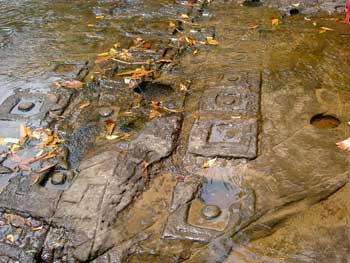
Các linga chạm nổi
Tôi nhát gan lắm ,và
lại hay sợ ma, tôi biết đất nước Campuchea nầy thần thánh lắm ,bỡi v́ ngoài việc
linh thiêng từ ngàn xưa của xứ nầy ,bây giờ c̣n có việc người chết rất nhiều ở
những nấm mồ chôn tập thể, mà thời đại Pôn Pốt Yêng Sary họ đă diệt chủng ,tôi
vẫn tin là có oan hồn đi rong rong dạo chơi quanh đâu đó...mà chưa thể đi đầu
thai kiếp khác được, nếu không có oan hồn làm sao có ma quy ? bởi v́ tôi cũng
vẫn thường xuyên nghe Cha xứ đạo của tôi bắt ma quỷ.
Thật đó các bạn ạ, tôi tin có một thế giới
huyền bí vô cùng sống song song với thế giới của chúng ta, mà khoa hoc và tôn
giáo chưa thể nào lư giải được ,chỉ biết như thế thôị.
Tôi là một người nhạy cảm quá chăng ? nên dể thấy nhiều hiện tượng tâm linh nầy
xăy rả người ở đất nước nầy nói rằng , có duyên lắm mới được gặp thánh thần như
tôi đăgặp .
Khi tôi kể lại cho những người đi trong nhóm , họ
nói họ đă từng ao ước gặp sự kiên nầy một lần ,để hiểu và thỏa măn sự ṭ ṃ về
nhiều điều kỳ bí... họ mơ ước gặp thần linh hơn là ma quỷ, nhưng có muốn
chứng kiến cũng không được, c̣n có cơ duyên nữa là điều mà người KHEMER thường
nói luôn luôn như vậỵ Chính điều nầy rất kỳ lạ đối với tôi, khi tôi leo núi .
Buổi sáng thức dậy, 6g sáng đă lên xe để đến nhà những
người bà con của nhóm bạn đi cùng, hôm qua sau khi chứng kiến việc thần thánh
quở phạt, tôi đi về chổ ở, chiều dự tiệc ,trong bàn tiệc
họ bàn nhau sáng nay ngủ dậy sớm , rồi chở nhau lên núi,
đi tắm suốị. Thác PHNOM KULEN nằm xa và trên núi cao,
muốn đi đến đây phải đi sớm, nếu đi trể quá, th́ khi vào cổng không kịp
giờ,những người trông coi khu du lịch sẽ không cho vào,
v́ khi đến cổng c̣n phải đi nhiều đoạn dài lắm ,khi th́ đi xe ,khi phải đi bộ ,v́
đường ngoằn nghèo khó đi. Qua khỏi cổng chúng tôi tiếp
tục leo lên xe đi, khá xa, nhưng đến nơi nầy th́ phải cuốc bộ rồị
Chỗ đầu tiên đến là hàng nướng , nguyên dăy dài gồm thịt
gà nướng, cá lóc, cá trê nướng, thịt heo rừng nướng, mùi thịt nướng thơm lừng ,nhất
là đang ở khu rừng với không khí thoáng mát, hương thơm của các thức ăn hoà
quyện trong không khí, làm mọi người ai cũng muốn ăn trước khi tắm suối, ăn với
cơm nóng bỏ bao sẳn, để trong các thùng ủ nhiệt, chúng ta chỉ trả gía cả rồi th́
bắt đầu bày ra bàn đứng ăn, tất cả thịt cá đều dùng bằng tay xé ăn , kèm
với gia vị trông ngon tuyệt vời , bỡi v́ hương thơm của núi rừng hoà quyện vào
thịt cá tươi nướng, tiếng suối , tiếng gió xào xạt làm tăng thêm thi vị của cái
bao tử đang sôi ...
À, Campuchea nổi tiếng về gà, gà nhiều lắm ,và chỉ có gà
ta thôi, thịt ngon và thơm, không mềm x́u như gà Mỹ . Ở
đây gà thường chiên để ăn , gà nướng nguyên con bằng lửa than rất hấp dẫn.
Chúng tôi xúm nhau lại bàn ăn, nói tiếng là bàn ăn nhưng chỉ là cái sạp phía sau
quán nướng, trong ṿng nữa giờđă làm sạch 6 con gà , 6 con cá lóc nướng, 3 con
cá khô, các thứ thịt rừng nướng vài chục bịt cơm nóng, với vô số trái cây mang
theo, vừa ăn vừa cười đùa giỡn trông giống ngày thơ của tuổi học tṛ...
Tranh thủ c̣n thời gian ăn, chưa lên khu chính của suối lớn, tôi rủ vài người
biết đường dẫn tôi t́m đến gịng suối nổi tiếng là linh
thiêng sẽ ban cho con người nhiều hạnh phúc khi đến rửa mặt tại đây, mà tôi có
nghe kể về gịng suối khi ngồi trên xe .
Gịng suối nầy chảy trên mười ngàn phiến đá có chạm trổ h́nh LINGA .
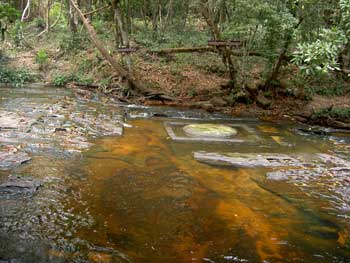
Linga lớn nhất
LINGA là danh từmỹ thuật để gọi tên các bức điêu khắc hay phù điêu đă được cách
điệu về bộ phận sinh dục nam nữ, mà người KHMER và người CHAMPA thờ phươ.ng. Một
h́nh vuông nhỏ ch́m bên trong h́nh vuông lớn, chính giữa là một khối tṛn, bên
ngoài h́nh vuông lớn ở giữa cạnh có một cái
rảnh nhỏ, toàn khối phù điêu đó là h́nh tượng Linga, hai dân tộc nầy tôn thờ
h́nh tượng nầy, đối với họ đời sống con người hạnh phúc no ấm là từ nơi đây .
Từ những bức phù điêu Linga nầy , ( gồm 2 loại Linga, Linga nhỏ khoăng 50x50cm,
Linga lớn, lớn hơn một mét) , khắc dài theo suối chảy, th́
biết nền văn minh của Campuchea ngày xưa to lớn biết bao . ( có h́nh chụp
minh họa)
Sau khi lội suối Linga rồi ,tôi và các người dẫn đường trở vềchổ ăn hồi năy, bạn
bè đang chờ chúng tôi lên xe đến suối lớn. Chúng
tôi xuống xe để đi bộ vào các nhà rông dọc con suối, thay đồ tắm để xuống suối
tắm...
Ḍng suối mát và trong sạch lắm , chúng tôi đùa nghịch té nước và lội qua lại ,tâm
hồn thư giăn khoan thai ở trong khung cảnh thiên nhiên nầy, ăn no tắm mát th́
c̣n ǵ bằng nữa các bạn nhỉ.
Sau khi lội suối một lúc, những người bạn Campuchea của
chúng tôi rủ nhau xuống tận nguồn suối để thấy thác đổ,
họ nói thác đổ mạnh và đẹp lắm ,nhưng phải đi xuống thung lũng sâu nữa, đi nhanh
lên mới kịp thời gian quay về, thế là tôi đi theo ho...Đi được một đoạn tôi thấy
trong ḷng bồn chồn như có chuyện ǵ đó ? một linh tính đến với tôi, tôi đi như
có ai gọi quay trở lại ? nhưng tôi vẫn tiếp tục đi dọc theo đường xuống thác,
th́ bất chợt có một người chạy theo gọi tôi quay trở lại, nói rằng có vợ chồng
cô em của bạn tôi muốn dẫn tôi đi lên núi chiêm ngưỡng Phật nằm, nếu tôi đi
xuống thác th́ lên núi không kịp, vậy quay về ngay để đi.
Tôi lưỡng lự v́ chưa thấy thác đổ, mà nh́n h́nh ảnh thác trong carte postal đẹp
quá , tôi nghỉ rằng ḿnh không muốn đi lên núi Phật nằm làm ǵ? v́ tôi vẫn mê
thiên nhiên hơn tâm linh thần thánh. Nhưng có cái ǵ réo gọi tôi về, chân tôi
vẫn bước theo đường xuống suối, nhưng cái đầu th́ bảo quay lại, lên núi ngay ,
chần chừ rồi đi lên , sau đó lại đi xuống , cứ như vậy ba
lần th́ tôi quyết định bỏ không xuống suối nữa , mà về
nhà rông thay quần áo tề chỉnh để lên núi Phật nằm.
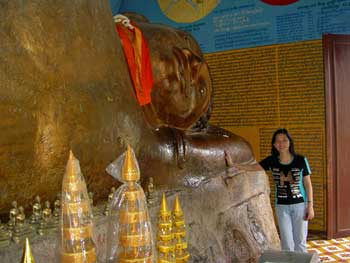
Đầu Phật
Đường lên núi Phật nằm quanh co trong rừng sâu, nếu như không có người dẫn đường
th́ không bao giờ tôi có thể biết nơi nầy để đi , nhưng nếu người dẫn đường là 2
vợ chồng em của người bạn, th́ họ cũng không dám dẫn đi, v́ vào rừng sâu nguy
hiểm, lạc đường... phải nhờ một người rất giỏi về đi rừng hái thuốc, dẫn đi.
Đến nơi ,nh́n 2 con đường rẽ, phải phán đoán đường nào là đường lên đúng chổ ,
leo lên đoạn dốc nữa, và lên những bậc thang đá th́ tôi bước vào cửa chùa " Phật
Nằm ".
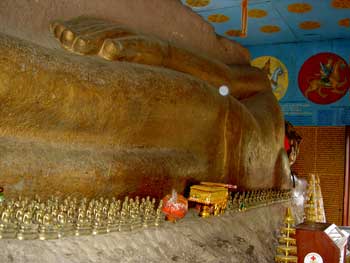
Tượng Phật nằm
Quan sát tượng Phật to lớn bằng đá nhủ vàng, tôi đến đốt nhang Phật, xong rồi đi
nh́n từng phần h́nh chạm khắc nầy, nghề nghiệp của tôi mà, tôi quan sát kỹ lưỡng
h́nh ông Phật nằm , cách tạo dáng trong nghệ thuật tranh Phật công phu vàđiêu
luyện, tôi nh́n thấy một viên Ngọc rất to cẩn vào rún của Phật, và ở đôi mắt
Phật có 2 viên Kim Cương sáng chói, có thể soi vào thấy bóng dáng của ḿnh.
Nh́n h́nh dáng Phật nằm cẩn trọng vàđúng tư thế của các tướng tốt , tôi áp dụng
sự hiểu biết về 32 tướng tốt trong nghệ thuật tạo h́nh tượng Phật ra để xem xét,
càng xem càng phục nền văn hoá xa xưa của người Khemer, họ hơn ḿnh rất xạ
Đi giáp ṿng tượng Phật, th́ thấy có 3 ông thầy người
Khemer, họ ngồi bên dưới chân tượng Phật để giải xâm, những người xin xâm, lá
xâm ghi tiếng Phạn, các ông thầy nầy sẽ giải số cho.
Tôi thấy người đi cùng tôi bảo tôi xin xâm, tôi cũng xin. Xâm là một cuốn
sách ghi những chữ Phạn ở trong, đưa cuốn sách lên đầu, và dùng một cái trâm của
các ông thầy đưa, châm trúng trang nào th́ ghép cây trâm tại đó, đưa sách lại
cho ông thầy , để ông mở ra đọc và giải nghĩa cho nghe.
Tôi vừa đưa sách cho ông thầy coi, vừa
nghe ông nói bằng tiếng Miên , người đi cùng tôi dịch cho nghe, đang nghe th́ tự
nhiên ông thầy bị Thần nhập, ông bắt đầu thay đổi nét mặt, thay đổi đôi mắt và
thay đổi giọng nói ngay...
Ông nh́n vào tôi nói một tràng tiếng ǵ tôi không hiểu, nghe như tiếng Tàu,
tiếng Nhật ,tiếng Thái, tiếng Khemer...và cứ chỉ vào tôi xử dụng danh từ Việt
Nam nầy ...VN nầy...
Tiếng nói ồn ào to lớn như sấm rền, mà cứ nh́n tôi bằng 2 con mắt đỏ mở rộng ra,
tôi th́ thất kinh khi gặp bất ngờ, không hiểu hết sự kiện huyền bí nầy , chỉ
ngồi bệt xuống đất mà nghe, nh́n, để ư xem chuyện ǵ... xem ḿnh có bị nguy hiểm
ǵ không ? nhiều người hành hương hướng cặp mắt nh́n tôi, họ biết tôi đang được
một sự kiện tâm linh thần thánh liên kết, cho phép nghe những ǵ người đang nói
và sẽ hiểu họ muốn nói ǵ...
Cuối cùng th́ một tràng tiếng Việt mà tôi nghe và hiểu là<< Người VN nầy, người
có ḷng thương người nhiều lắm , người đă xúc động khi mới bước chân đến đất
nước thiêng liêng nầy, gặp người nghèo khó người thương xót chia sẽ...người sẽ
được...những ǵ sau nầy người được ....người nhớ ...hăy quay lại đây ...người có
hứa không ? Tôi ngớ người, tôi cũng không biết là ḿnh phải nói saỏ ḿnh phải
làm ǵ ? và có nên hứa không ? tiếng nói lập lại vài lần : Có hứa không ?
Tôi chợt nghỉ đến chuyện hứa bậy bạ với thần tiên mà không làm th́ dể bị vật
chết lắm, nên im lặng, nhưng khi suy nghi rằng << Điều hứa nầy phụ thuộc vào
việc chứng minh thật sự có thần thánh không? Có linh thiêng không ?>> nên khi
nghe hỏi lần nữa tôi trả lời rằng hứa.
Sau lời hứa của tôi th́ mọi việc trở lại b́nh thường, yên lặng trở lại trong
ngôi chùa , c̣n tôi th́ trở nên suy tư hơn. Tôi hoang mang lắm, không hiểu sao
người ta lại nói được tiếng Việt, khi không hề biết ǵ về tiếng Việt? Tôi đă
nghỉ ǵ? làm ǵ ? đều bị nghe thấy ,thật sự đất đai nầy
thần thánh đến như vậy saỏ sự hiệp thông nầy đă cho tôi một hướng đi mới khi
nghỉ về tôn giáo nầỵ
Những ngày dong ruổi sau đó đến Nong Penh, thưởng lăm các công tŕnh xây dựng cổ
kính , Hoàng Cung, đền Độc Lập...mỗi bước đi là mỗi hiểu biết thêm về đất nước
chỉ c̣n hơn 3 triệu dân, đất rộng người thưa, thức ăn nhiều , nhưng sao vẫn
nghèo khổ .
Có một điều khi tôi gặp những người tu hành đi khất
thực trên đường phố, tôi phải thán phục họ , v́ họ đă để lại ấn tượng trong tôi
về phong thái của kẻ tu hành , không màng đến lợi danh, bước di êm nhẹ như gió
thoảng ...
KC
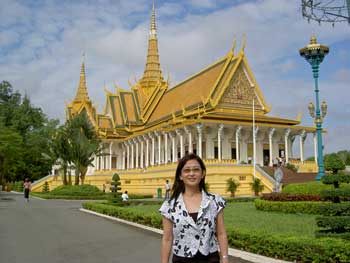
Hoàng Cung
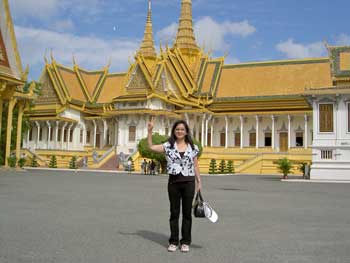
Hoàng Cung ở PnomPenh
